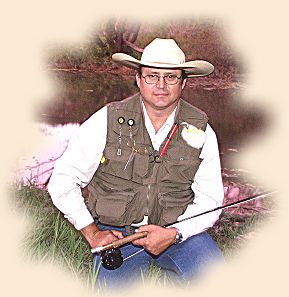Grasshoppers, or commonly known among fly fishers,
Hoppers, play a big part in the fly fishers life,
especially when summer rolls around each year. It
simply does not matter whether you are fishing for
trout, panfish, bass or most any other species, fish
love hoppers, they seem to be a delicacy to them. If
you have ever watched a hopper get caught by wind or
simply miss its mark and land out on water, you'll know
what I mean. Hoppers are excellent swimmers and their
hind legs propel them rather well to shore. However it's
this kicking action that spells their doom.
There is nothing like walking along the water with hoppers
taking to the air as you pass by. Eventually one or more
will land on the water and within a few seconds will simply
disappear! If that does not stir the primal need to fish,
nothing ever will. That is my biggest problem; you see my
back lawn parallels a beautiful creek. As I am mowing that
section, hoppers are jumping and flying before me to escape
the mower. Any that go out onto the water are instantly
taken by one of the creeks various species of fish. That
addiction to fishing just takes over and the mower is
instantly traded for a fly rod and a box of hoppers.
Funny, the grass is always higher along the creek than
anywhere else in the back lawn. I tell the wife it's
because of the constant water supply. Think she believes
that, probably not, just humoring me.
Fly tiers have been trying to imitate hoppers probably
since the first one noticed the reaction of fish to the
swimming hopper. There are so many variations of hoppers,
from the simple quick tie to the more complex and realistic
imitations. Searching the Internet using Google.com with
"hopper pattern" brings up many pages of fly fishing sites
with all kinds of variations of the hopper pattern. As
most would guess FAOL was the first listed, "Fly Angler's
Online "Beginning Fly Tying part 30". By our own Al Campbell.
FAOL also held the second spot with Part 31 also. Thank you Al.
Just about every material has been used to form hoppers;
hair, feathers, dubbing, synthetics of every sort and
foam. With these materials boundless techniques, stacking
and or spinning hair, wrapped dubbing, stacking foam,
wrapping foam, wrapping and counter wrapping of hackle
and on and on, have formed many variations of the hopper
pattern. As you can see the hopper is one of the most
versatile patterns out there. They are also a good pattern
for beginner tiers due to the numerous variations of tying
methods, from super easy to the complexity of spinning deer
hair.
The nice thing about hopper patterns is that all the
patterns seem to work and especially well with the
sunfishes, larger sizes work well with bass, especially
pond bass. Everyone can find that "one" pattern that
works for them and best fits their tying abilities.
Color is a large factor when selecting material for
the hopper. If I plan on fishing Brushy Creek, San
Gabriel or the Llano River I need yellow or tan hoppers.
If I plan to fish the Blanco on the 5-mile dam area,
better have light green hoppers. So if hoppers are in
your plans for this coming summer, check out the local
population for color and general size before buying
material.
One of my favorite hopper patterns is a tri-colored foam
hopper pattern that is easily varied for whatever part
of the country fished. I saw this pattern some time back
and in a non-fishing magazine as part of a prop for their
ad. After a few tries I got it to look pretty close.
Fishing with it proved it to be a successful pattern.
Again it has surfaced in another magazine, actually a
catalog, for fly-fishing. I have no idea of the official
name for this hopper so I just call it the Tri-Foam Hopper.
If anyone knows what it is called it would be Skip Morris
as his foam flies are remarkable and Jim Hatch who also
does incredible work with foam. Some of you have probably
seen this pattern but for those who have not, allow me to
present the fly and instructions to help you prepare for
this summer's fishing.
Materials: Tri-Foam Hopper
Thread: Orvis G olive.
Hook: Orvis #1638 2X-long Dry size 10.
Body: Three pieces of craft foam typically ½
inch wide by 3 inches long, of colors that work in your
area. For example mine are green, yellow and tan.
Legs: Rubber leg material again in the color of your area.
Visual Indicator: (Optional) bright fluorescent yarn.
Misc: Zap-a-Gap glue.
Instructions:
1. Take the three pieces of foam and glue together
with the Zap-a-gap. Wait about a minute before cutting
into strips. For the hook of this hopper cut the foam
into about 3/8 inch strips.
2. Place a bed of thread onto the hook and lay a thin
bead of Zap-a-Gap onto the thread bed. Place the cut
strip of foam onto the thread bed with the Zap-a-Gap
and hold for a few seconds for the body to take hold
of the hook.
3. Tie in the thread at the head and take two wraps.
Wrap the thread back about 1/8 inch and take two wraps.
With each two wraps compress the foam about half its
thickness. You should get 4 sets of double wraps using
the hook of this article. Whip finish the last wrap and
cut the thread.
4. Cut the extra foam off the tail section again about
1/8 inch beyond the hook bend and this will give a nice
flare for the tail section of the hopper.
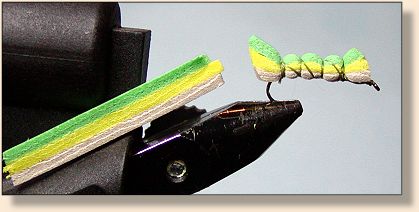
5. Take the rubber leg material and remove two sections,
with three rubber strands attached, the length equal to
two and a half times the length of the hopper body. Tie
a square knot a half-inch from one end of each leg giving
the knee bend of the leg. For each leg, on the long side
of the knot, remove one strand of rubber and put aside for
later.

6. Take the thread and take a couple of over lapping
turns where the first wrap was at the head. Lay the
short side of the legs against the sides of the body
and tie in with a couple of wraps. At this point you
can decide just how much angle you want in the legs.
7. Now take the extra leg material you removed in step
5 and tie in under the main legs in the "X-wing" fashion.
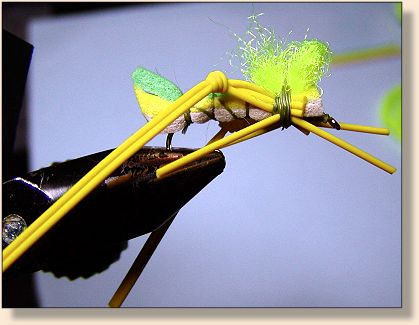
8. Trim the back legs to your desired length and then
two optional things that can be done is tying in some
bright neon poly yarn for easier sighting on the water
and use waterproof pen for giving the legs a distinctive
look.
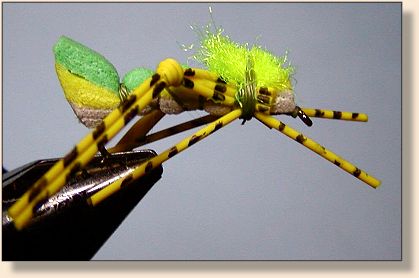
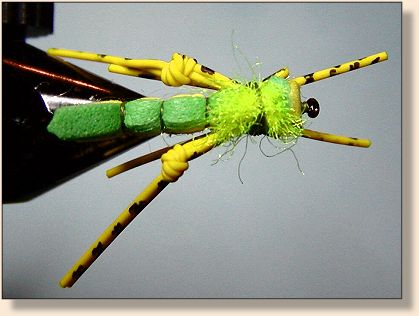
-
When sitting on the table they have a good appearance
of a hopper and apparently to the fish as well.
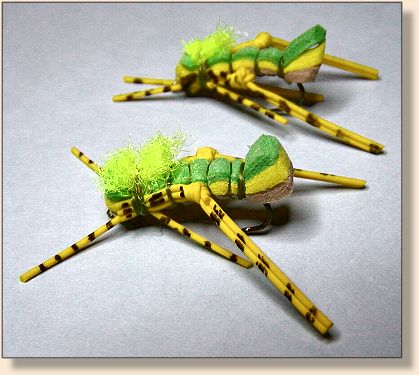
-
Until next time, good fishing!
~ Hillfisher
|

